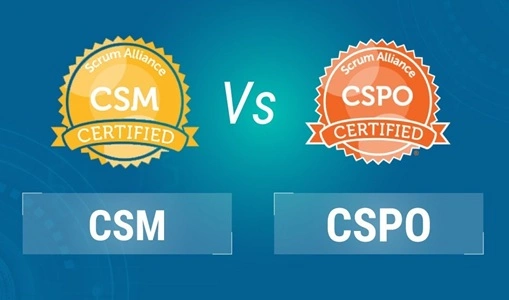The Certified ScrumMaster (CSM) and Certified Scrum Product Owner (CSPO) certifications are among the most popular credentials in the Agile and Scrum world. Offered by Scrum Alliance, these certifications are highly valued in IT, product development, DevOps, business analysis, and project management roles. Many professionals pursue both certifications to strengthen their Agile knowledge and improve their career opportunities.
If you want to know how to get CSM and CSPO certifications, this guide will walk you through the complete process—from eligibility to exam format and preparation tips.
1. Understand What CSM and CSPO Certifications Are

Certified ScrumMaster (CSM)
This certification focuses on:
- Scrum roles, events, and artifacts
- Team facilitation
- Coaching principles
- Sprint planning and retrospectives
- Removing team blockers
CSM is suitable for Scrum Masters, Agile coaches, team leads, QA professionals, and even beginners transitioning into Agile.
Certified Scrum Product Owner (CSPO)
This certification focuses on:
- Product vision and strategy
- Backlog creation and prioritization
- Working with stakeholders
- User stories and acceptance criteria
- Delivering product value
CSPO is ideal for product owners, business analysts, project managers, and anyone who wants to work closely on product development.
2. Check the Eligibility Requirements
One advantage of both CSM and CSPO certifications is that there is no strict eligibility requirement. You do not need prior Scrum experience, project management certification, or a technical background.
Anyone interested in Agile and Scrum can enroll.
3. Choose a Scrum Alliance Certified Trainer (CST)
To get CSM or CSPO certified, you must attend a mandatory 2-day training conducted by an authorized Certified Scrum Trainer (CST). These trainings can be:
- Online (live instructor-led)
- In-person classroom sessions
Choose a trainer or institute that is recognized, experienced, and provides practice materials.
Popular training providers include:
- Scrum Alliance Certified Trainers
- KnowledgeHut
- Simplilearn
- Edureka
Always verify whether the training is directly associated with Scrum Alliance.
4. Complete the 2-Day Mandatory Training
The two-day workshop is interactive and includes case studies, group exercises, role plays, and real-world Scrum examples.
During CSM Training, You Learn:
- Scrum framework
- Agile mindset
- How to remove impediments
- Facilitating Scrum ceremonies
- Coaching and mentoring teams
During CSPO Training, You Learn:
- Product vision and roadmap
- Customer research
- Backlog prioritization techniques (MoSCoW, WSJF, Kano)
- User story mapping
- Working with cross-functional teams
You must attend the full training to receive the certification eligibility.
5. Take the CSM Certification Exam
After completing the CSM training, Scrum Alliance sends you a link to take the official exam.
CSM Exam Details:
- Format: Online, open-book
- Number of Questions: 50 multiple-choice
- Passing Marks: 74% (37 correct answers)
- Duration: 60 minutes
- Attempts: First two attempts are free
Once you pass the exam, you officially become a Certified ScrumMaster.
6. CSPO Certification Does Not Have an Exam
Unlike CSM, the CSPO certification does not require an exam. After completing the two-day CSPO training, Scrum Alliance directly awards you the certification.
This makes CSPO one of the easiest entry points into the Agile and product management world.
7. Receive Your Certificate and Create a Scrum Alliance Profile
After passing CSM (or after completing the CSPO training), you will receive:
- A Scrum Alliance digital certificate
- A two-year membership to Scrum Alliance
- Access to global networking and job opportunities
You can also add the certification to LinkedIn, your CV, and job portals.
8. Renew Your Certifications Every Two Years
Both CSM and CSPO certifications are valid for 2 years. To renew, you must:
- Earn 20 Scrum Education Units (SEUs)
- Pay the renewal fee through Scrum Alliance
You can earn SEUs by attending webinars, taking online courses, reading Scrum books, or participating in Scrum events.
9. Prepare Effectively for the Training and Exam
While the certifications are easier compared to PMP or AWS DevOps, preparation still helps.
Tips to Prepare for CSM and CSPO:
- Read the Scrum Guide (latest version — 13 pages only)
- Understand Agile values from the Agile Manifesto
- Watch Scrum explainer videos
- Take sample quizzes for CSM
- Read case studies about Agile transformation
10. Benefits of Getting CSM and CSPO Certifications
Professionals with CSM and CSPO enjoy:
- Higher salary packages
- Higher chances of getting jobs in Agile environments
- Better understanding of product development
- Flexibility to work across industries
- Strong leadership and communication skills
- Opportunities to transition into Scrum Master or Product Owner roles
In India, demand for Scrum and Agile professionals continues to grow as companies adopt modern delivery frameworks.
Conclusion
Getting the CSM and CSPO certifications is a smart career move for anyone stepping into Agile, Scrum, DevOps, project management, or product development. With no strict eligibility requirements and a simple training-focused pathway, these certifications give you both practical knowledge and strong global recognition.
By choosing the right trainer, attending the mandatory workshop, completing the CSM exam, and understanding Scrum concepts deeply, you can successfully earn both CSM and CSPO certifications and accelerate your career in the Agile world.